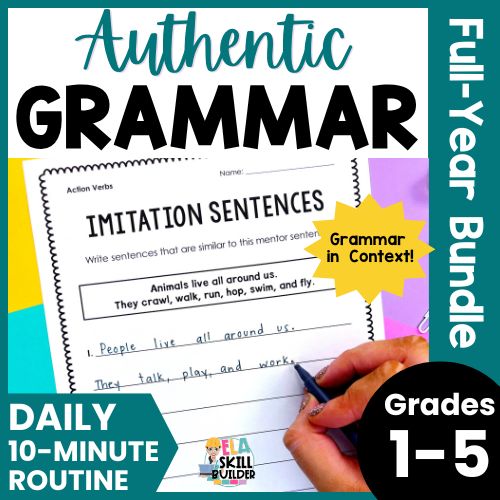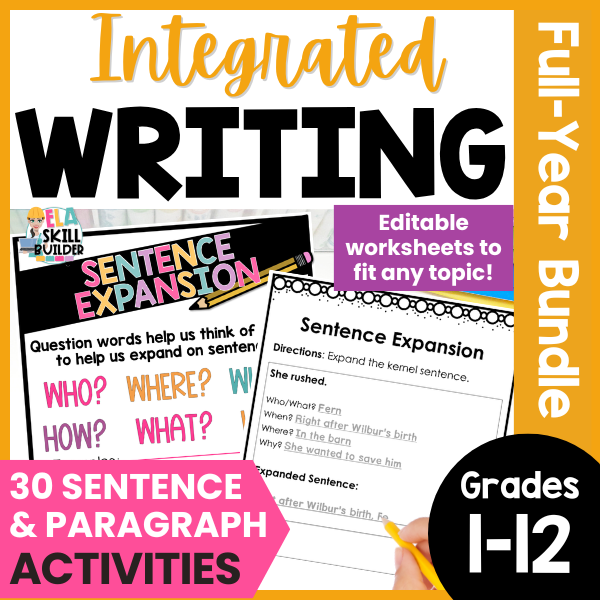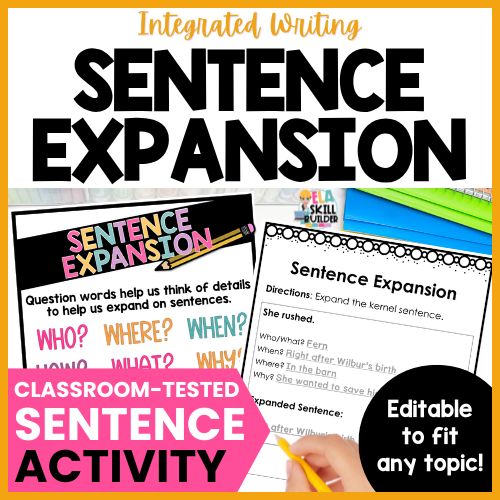
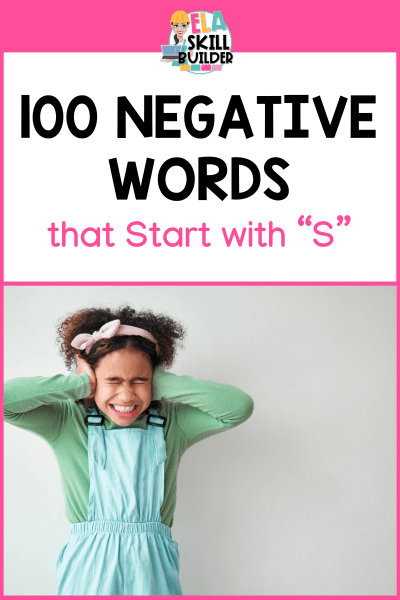
100 Negative Words That Start with the Letter “S”
Need a list of negative words that start with S? Look no further!
Imagine this: You’re reading a story with your students, and the main character is in a rough spot. You ask, “How do you think they feel?” Hands shoot up, and you hear “bad,” “sad,” and maybe “angry.” But you know there’s more to it than that. How can we help students describe feelings with a bit more depth?
This is where knowing a wider range of vocabulary—including words for negative feelings and negative emotions—can make a big difference. Words with shades of meaning help students express themselves, whether they’re talking about their own experiences, analyzing characters, or experimenting with creative writing. And while it might seem unusual to focus on negative words, understanding them can be just as valuable as learning positive ones.
In this post, we’ve gathered 100 negative words that start with S for when a bit of edge is needed. This negative words that start with S list can be used as starting point for more creative ways to help students expand their language skills. Let’s explore why and how these words can become a meaningful part of vocabulary lessons!

Why Teach Negative Words that Start with S?
Teaching both positive and negative words helps students develop a richer vocabulary, allowing them to describe emotions and experiences with greater accuracy. This vocabulary variety goes beyond simple labels like “bad” or “mean,” giving students the language to explore a character’s motives and traits in more specific ways.
Negative words that start with S are particularly useful for helping students express emotions and analyze character traits. Words like “sullen” or “skeptical” provide tools for understanding complex characters and emotions, which strengthens both reading comprehension and self-expression.
Students encounter negative words that start with S in stories and real-life situations every day. When reading about a character who feels “scared” or “shamed,” students can connect these words to their own experiences and emotions. This expanded vocabulary also gives them the words to talk about their personal feelings.
Teaching Tips for Introducing Negative Words
Introducing negative words that start with S to elementary students requires a thoughtful approach, as they can be a powerful tool for expressing emotions, actions, and situations. Here are some tips to ensure the process is both effective and age-appropriate.
1. Have Age-Appropriate Guidelines
When teaching negative words that start with S, it’s important to make sure the language is suitable for the students’ developmental level. Start by explaining that negative words are simply descriptive tools used to express feelings, actions, or situations. Emphasize that these words are not meant to label people as “bad” but to describe specific behaviors or moods. Provide examples that are relatable and easy to understand, like “silly,” “sad,” or “shy,” before moving on to more complex words.
2. Use a List of Positive Words for Balance
While teaching negative words that start with S, it’s also a great idea to introduce a list of positive words. This helps students understand the full range of vocabulary available to them and see the contrast between the two. Balance is key, as using a mix of both positive and negative words enables students to express themselves more fully. Encourage students to describe characters, situations, or even their own emotions using both types of words. For example, a character might be “brave” (positive) but also “stubborn” (negative), giving a more well-rounded view of their personality. Introducing positive alternatives alongside negative words can help students find a range of expressive choices in their writing.
3. Contextualize Negative Words in Stories
To help students understand how negative words that start with S function, it’s helpful to place them in context. Have students read short stories or book excerpts where characters display negative traits. As they read, ask them to highlight the negative words used to describe the characters or situations. Then, have them discuss how these words help shape the story’s tone and the characters’ actions. This exercise will deepen their understanding of how negative words contribute to narrative development.
4. Role-Play to Understand Negative Traits
Role-playing can be a fun and effective way to help students internalize negative words that start with S. Assign different negative traits (like “stubborn,” “sly,” or “sneaky”) to pairs of students and have them act out scenarios where these traits come into play. Encourage students to focus not only on their actions but also on their facial expression, as this adds depth to their portrayal of the character. After each role-play, ask the class to identify which words best describe the characters’ behavior. This interactive approach allows students to see how negative words that start with S are used in real-life situations, enhancing their comprehension and vocabulary skills.
5. Implement a “Word of the Day”
Make learning fun with a “Word of the Day” activity! Each day, introduce a new negative word that starts with S (like “stubborn” or “sullen”) and challenge students to use it in a sentence throughout the day. At the end of the day, have them share their sentences with the class. This not only boosts vocabulary but also helps students practice using the word in context.
These activities not only help students understand negative words that start with S but also encourage them to apply them creatively in their speaking, writing, and reading.
By following these guidelines, you’ll help students build a strong vocabulary and understand how to use negative words that start with S constructively in their writing and communication.
Ultimate List of Negative Words that Start with S
In this section, we’ll explore 100 negative words that start with S and carry negative connotations. To make it easier to navigate, we’ve organized them into categories, including words that describe personality traits, actions, settings, and adverbs. Example sentences are also provided to show how each word is used in context.
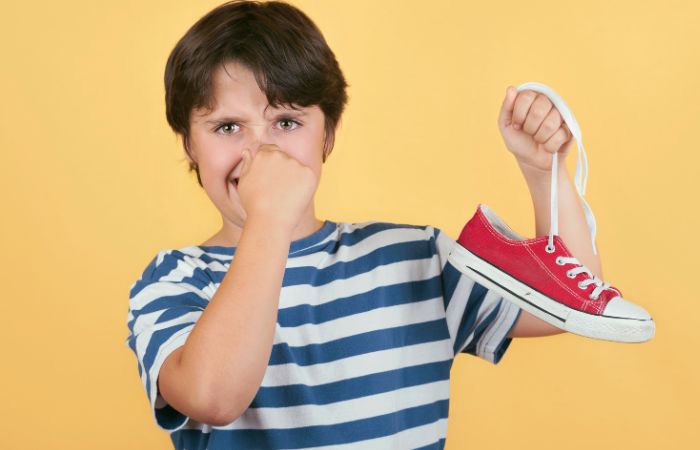
25 Negative Adjectives that Start with S
These negative words that start with S include a list of negative adjectives that describe personality traits, emotions, or moods, helping students express more specific characteristics.
- Selfish – She was too selfish to share her crayons with her classmates.
- Stubborn – He was too stubborn to listen to anyone’s advice, even when he was clearly wrong.
- Sarcastic – Her sarcastic comments made everyone feel uncomfortable and upset.
- Sly – The sly fox managed to escape the trap without anyone noticing.
- Sneaky – He was being sneaky when he hid his homework so he wouldn’t have to do it.
- Spoiled – The spoiled child always threw a tantrum when she didn’t get what she wanted.
- Suspicious – He was suspicious of the new student because he hadn’t seen him around before.
- Spiteful – She made spiteful remarks about her friend just to make her feel bad.
- Self-centered – His self-centered attitude made it hard for him to make real friends because he only cared about himself.
- Scheming – The scheming villain tried to come up with a plan to steal the treasure.
- Secretive – He was secretive about his birthday plans, not telling anyone what he was going to do.
- Shallow – Her shallow interest in the latest trends made it hard for her to get to know people.
- Short-tempered – He had a short-tempered reaction when he lost the game, shouting and stomping his feet.
- Stingy – The stingy man wouldn’t share his snacks with anyone, even when they asked nicely.
- Scornful – She gave a scornful look when her teammate suggested they work together on the project.
- Self-absorbed – He was so self-absorbed that he never noticed when others needed help.
- Spineless – The spineless character didn’t stand up for what was right, even when he knew it was important.
- Superficial – Her superficial thoughts about what others wore made her forget that kindness was more important.
- Sluggish – The sluggish runner took a long time to finish the race, even though he had trained for weeks.
- Sentimental – His sentimental attachment to his old stuffed animal made it hard for him to let it go.
- Shifty – The shifty man kept glancing around as if he was trying to hide something.
- Smug – She gave a smug smile after getting the highest score in the class, thinking she was better than everyone.
- Sullen – His sullen face showed that he was upset, but he didn’t want to talk about it.
- Subversive – His subversive ideas about how to improve the classroom caused some students to question the rules.
- Sloppy – His sloppy handwriting made it difficult for the teacher to read his answers on the test.
These descriptive adjectives provide a detailed way to describe various negative traits and behaviors. Understanding these negative words that start with S can help students recognize and articulate more specific emotions and characteristics in themselves and others.
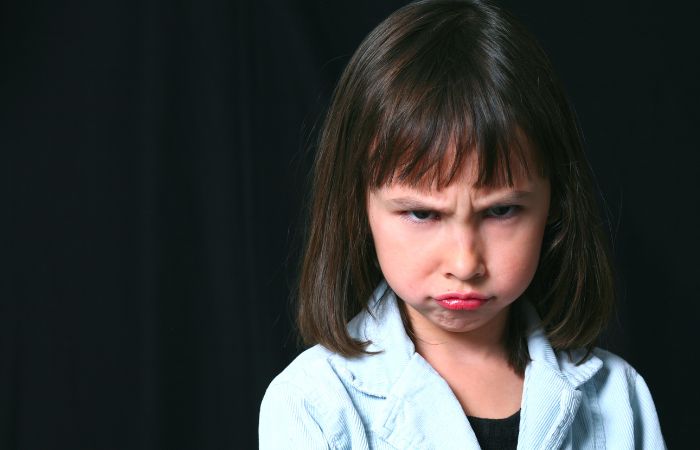
25 Negative Action Words that Start with S
These negative words that start with S describe actions that may be harmful or undesirable, perfect for character analysis or story development.
- Sabotage – The boy tried to sabotage the class project by hiding the important papers.
- Sneer – She sneered at the new student when he asked a question in class.
- Scold – The teacher had to scold the students for talking during the test.
- Steal – He was caught trying to steal a pencil from his friend’s desk.
- Slander – It’s wrong to slander someone by saying things that aren’t true.
- Spy – He decided to spy on his friend to see what surprise he was planning.
- Shove – She had to shove past the crowd to get to the front of the line.
- Scoff – He would scoff at his classmates when they made suggestions during group work.
- Swindle – The man tried to swindle people out of their money by selling fake toys.
- Storm – She stormed out of the room after her brother broke her favorite toy.
- Slap – He slapped his hand on the table in frustration after losing the game.
- Shirk – He tried to shirk his chores by saying he didn’t know how to do them.
- Snub – She felt snubbed when her friends didn’t invite her to join the game.
- Scam – They warned the children about online scams where people trick others into giving them money.
- Subvert – He tried to subvert the class rules by convincing others not to follow them.
- Sneak – She would sneak extra cookies when her parents weren’t looking.
- Spit – He angrily spat on the ground after losing his race.
- Slink – The cat slinked away after knocking the cup off the table.
- Snatch – She tried to snatch the last piece of cake before anyone else could grab it.
- Sham – The charity event turned out to be a sham, and no one received the prizes promised.
- Smear – The boy tried to smear his friend’s reputation by telling lies about him.
- Stab – She felt like her teammate had stabbed her in the back when they took credit for her idea.
- Shackle – His fear of failing seemed to shackle him, making it hard for him to try new things.
- Scathe – Her feelings were scathed after hearing the unkind comments from her classmates.
- Snarl – The dog began to snarl when someone tried to take its toy.
The use of words in this section highlights how negative “S” words can describe harmful actions, aiding in character analysis and storytelling. Words like “sabotage” and “slander” help students portray negative behaviors and add depth to their writing.
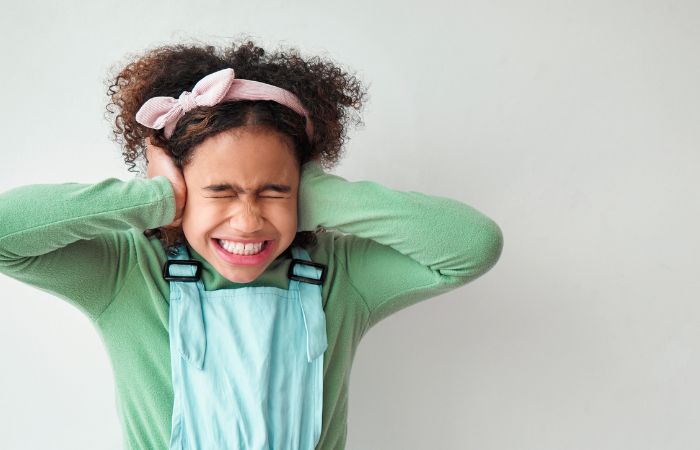
25 Negative Descriptive Words that Start with S
These negative words that start with S set the mood and describe negative qualities in environments or situations. Here are some examples of adjectives that help paint a vivid picture of challenging settings.
- Stormy – The stormy night made it hard to see the road, with rain pouring down and lightning flashing.
- Suffocating – The air felt suffocating in the small room with no open windows, making it hard to breathe.
- Stifling – The stifling heat in the classroom made it difficult to concentrate on our lessons.
- Shabby – The shabby old house had peeling paint and a broken fence, making it look uncared for.
- Secluded – The secluded park was quiet, and it felt like we were the only ones there.
- Slimy – The slimy mud stuck to my shoes as I walked through the puddle.
- Sparse – The sparse decorations in the room made it feel empty and not very inviting.
- Sticky – My hands were sticky after I spilled juice all over the table.
- Shadowy – The shadowy corner of the room made it hard to see, and I felt a little scared.
- Smelly – The smelly trash had been sitting outside for too long and was starting to rot.
- Soggy – The soggy ground after the rain made it hard to walk without slipping.
- Smoggy – The city felt smoggy, with thick fog in the air that made it hard to breathe.
- Silent – The silent classroom made everyone nervous as we waited for the test to begin.
- Slippery – The slippery ice on the sidewalk made it tricky to walk without falling.
- Sweltering – The sweltering heat made everyone at the picnic seek shade under the tree.
- Squalid – The squalid conditions of the old building made it clear that no one had lived there for years.
- Shimmering – The shimmering waves in the lake sparkled brightly under the afternoon sun.
- Subdued – The subdued lighting in the room made everything feel calm and peaceful.
- Stagnant – The stagnant water in the pond started to smell bad, and mosquitoes began to swarm around it.
- Surly – The surly waiter didn’t smile once and seemed annoyed when we asked for more water.
- Subpar – The subpar lunch at the cafeteria didn’t taste very good, and most of us didn’t finish our food.
- Stark – The stark, white walls in the room made it feel cold and uninviting.
- Shuddering – The shuddering walls of the old house creaked every time the wind blew, making it feel eerie.
- Shrill – The shrill sound of the whistle made everyone stop what they were doing and look up.
- Sordid – The sordid details of the story made everyone feel uncomfortable and embarrassed.
Choosing the right words is essential when describing environments and situations. Negative words that start with S like “suffocating” or “stormy” can help create a vivid atmosphere, giving students the tools to paint a clear picture of challenging settings in their writing.
25 Negative Adverbs that Start with S
Negative words that start with S can be a powerful tool for describing actions and behaviors in writing. By incorporating these negative adverbs into their vocabulary, students can add more depth and emotion to their stories, helping to convey a stronger sense of negativity or discomfort.
- Sullenly – He sullenly stared out the window, not feeling like playing with the other kids.
- Stubbornly – She stubbornly refused to share her crayons, even though her friend needed them.
- Suspiciously – He looked suspiciously at the new student, wondering why he wasn’t talking to anyone.
- Sharply – The teacher sharply told the students to sit down and pay attention when they were being too noisy.
- Selfishly – He selfishly took the last cookie for himself, even though he knew his sister wanted it.
- Sadly – She sadly watched her classmates walk to the bus without her because she forgot her jacket.
- Scornfully – He scornfully shook his head when his friend suggested they play a game he didn’t like.
- Sloppily – He sloppily wrote his name on the paper, making it hard to read.
- Skeptically – She skeptically looked at the new rule, not sure it would make the game more fun.
- Subversively – He subversively changed the rules of the game to make it easier for him to win.
- Slightly – She slightly moved her chair to get a better view of the presentation.
- Sporadically – He sporadically did his chores, often forgetting to finish them completely.
- Silently – She silently picked up her books after the bell rang, ready to leave the classroom.
- Severely – He severely scolded his dog for chewing on his shoes.
- Shakily – She shakily held her ice cream cone, afraid it might fall before she could take a bite.
- Stealthily – He stealthily crept past the sleeping dog to grab his favorite toy.
- Slyly – She slyly passed the note to her friend during class, hoping the teacher wouldn’t see.
- Sluggishly – He sluggishly walked to the bus stop, feeling tired after a long day at school.
- Surreptitiously – He surreptitiously peeked at his friend’s paper to see the answer to the question.
- Sourly – She smiled sourly when she found out she didn’t win the prize in the contest.
- Shatteringly – The news of the game being canceled was shatteringly disappointing to the whole team.
- Substantially – Her answer was substantially longer than everyone else’s, showing how much effort she put in.
- Sleepily – He sleepily rubbed his eyes during the morning lesson, still tired from staying up late.
- Shamelessly – He shamelessly bragged about getting the highest score in the class during the spelling test.
- Shimmeringly – The water shimmeringly sparkled in the sunlight, making the lake look magical.
Negative adverbs that start with S add nuance and intensity to writing, allowing students to express actions and behaviors in a more detailed way. By incorporating these adverbs, students can enhance the emotional depth of their stories, making their characters’ actions and reactions feel more vivid and impactful.
Conclusion
As teachers, it’s important to create an environment where students feel comfortable experimenting with language. The more they explore both positive and negative words, the more tools they’ll have to express themselves clearly. Whether they’re describing a character or their own emotions, a well-chosen word can make all the difference.
By expanding their vocabulary with both common and more obscure negative words that start with S, students gain a greater word power that allows them to convey thoughts and feelings more precisely. Whether it’s through learning the nuances of the English language or experimenting with negative words, students can enrich their communication skills and grow as writers.
At the end of the day, words are just tools for expression. Helping students build a strong vocabulary—both positive and negative—gives them the power to communicate more effectively. So, encourage your students to have fun with language and see where their creativity takes them!
Full-Year Grammar & Writing Curriculums
Check out these best-selling grammar and writing resources for grades 1-5! Aligned with elementary language and writing standards, these materials offer systematic and explicit instruction to help your students become confident, independent writers.

Related Posts
How to Run a Writing Workshop in Elementary


Hey Teachers,
I'm Jen from
ELA Skill Builder!
My mission is to empower elementary teachers like you with the tools and confidence to teach writing effectively, so your students can grow into strong, capable writers.
Best Sellers!
Writing resources
Features explicit writing workshop lessons for narrative, informational, and opinion writing.
Grammar resources
Features a simple weekly routine that teaches grammar in context in just 10 minutes a day.
writing prompts
Features 810 prompts designed to strengthen paragraph writing skills all year long!
cross-curricular writing
Features 30 sentence and paragraph activities inspired by The Writing Revolution that fit any subject.
coupon code
Get 15% off Your First Purchase
free lessons!
Grab 5 free prewriting lessons to kick off your narrative writing unit – all materials included!
jOIN A COMMUNITY
writing training
Features 4 hours of video lessons designed to help you run a structured, effective, and engaging writing block.
free gramamr routine!
Features a free 5-day routine for teaching any grammar skill in context, in just 10 minutes a day!
free SENTENCE ACTIVITY
Features a free, editable sentence activity that helps students expand sentences for any topic.
contact jen!
Got questions? Fill out this contact form, and I’ll get back to you as soon as possible.




